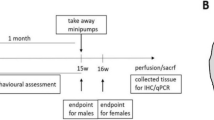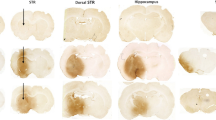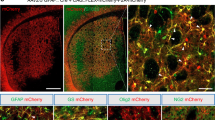Abstract
Huntington's disease is a genetic disorder that results from degeneration of striatal neurons, particularly those containing GABA (γ-aminobutyric acid)1. There is no effective treatment for preventing or slowing this neuronal degeneration. Ciliary neurotrophic factor (CNTF) is a trophic factor for striatal neurons2,3 and therefore a potential therapeutic agent for Huntington's disease. Here we evaluate CNTF as a neuroprotective agent in a non-human primate model of Huntington's disease. We gave cyno-molgus monkeys intrastriatal implants of polymer-encapsulated baby hamster kidney fibroblasts that had been genetically modified to secrete human CNTF. One week later, monkeys received unilateral injections of quinolinic acid into the previously implanted striatum to reproduce the neuropathology seen in Huntington's disease4,5. Human CNTF was found to exert a neuroprotective effect on several populations of striatal cells, including GABAergic, cholinergic and diaphorase-positive neurons which were all destined to die following administration of quinolinic acid. Human CNTF also prevented the retrograde atrophy of layer V neurons in motor cortex and exerted a significant protective effect on the GABAergic innervation of the two important target fields of the striatal output neurons (the globus pallidus and pars reticulata of the substantia nigra). Our results show that human CNTF has a trophic influence on degenerating striatal neurons as well as on critical non-striatal regions such as the cerebral cortex, supporting the idea that human CNTF may help to prevent the degeneration of vulnerable striatal populations and cortical–striatal basal ganglia circuits in Huntington's disease.
This is a preview of subscription content, access via your institution
Access options
Subscribe to this journal
Receive 51 print issues and online access
$199.00 per year
only $3.90 per issue
Buy this article
- Purchase on Springer Link
- Instant access to full article PDF
Prices may be subject to local taxes which are calculated during checkout
Similar content being viewed by others
References
Reiner, A. et al. Differential loss of striatal projection neurons in Huntington's disease. Proc. Natl Acad. Sri. USA 85, 5733–5737 (1988).
Anderson, K. D., Panayotatos, N., Cordoran, T. L., Lindsay, R. M. & Wiegand, S. J. Ciliary neurotroophic factor protects striatal output neurons in an animal model of Huntington's disease. Proc. Natl Acad. Sci. USA 93, 7346–7351 (1996).
Emerich, D. F. et al. Implants of encapsulated human CNTF-producing fibroblasts prevent behavioral deficits and striatal degeneration in a rodent model of Huntington's disease. J. Neurosci. 16, 5168–5181 (1996).
Beal, M. F. et al. Replication of the neurochemical characteristics Huntington's disease by quinolinic acid. Nature 32l, 168–171 (1986).
Beal, M. F., Kowall, N. W., Swartz, K. J., Ferranti, R. J. & Martin, J. B. Differential sparing of somatostatin-neuropeptide Y and cholinergic neurons following striatal excitotoxin lesions. Synapse 3, 38–47 (1989).
Emerich, D. F. & Sanberg, P. R. in Neuromethods: Animal Models of Neurological Disease (eds Boulton, A. A., Baker, G. B. & Butterworth, R. F.) Vol. 17, 65–134 (Humana, New Jersey, 1992).
Ferrante, R. J., Beal, M. F., Kowall, N. W., Richardson, E. P. & Martin, J. B. Sparing of acetylcholi-nesterase-containing striatal neurons in Huntington's disease. Brain Res. 415, 178–182 (1987).
Roberts, R. C. & DiFiglia, M. Short- and long-term survival of large nurons in the excitotoxic lesioned rat caudate nucleus: a light and electron microscopic study. Synapse 3, 363–371 (1989).
Albin, R. L. & Greenamyre, J. T. Alternative excitotoxic hypothesis. Neurology 42, 733–738 (1992).
Beal, M. F. Does impairment of energy metabolism result in excitotoxic neuronal death in neurodegenerative illnesses? Ann. Neural. 31, 119–130 (1992).
Parker, W. D., Boyson, S. J., Luder, A. S. & Parks, J. K. Evidence for a defect on NADH:ubiquinone oxidoreductase (complex I) in Huntington's disease. Neurology 40, 1231–1234 (1990).
Wallace, D. C. W Mitochondrial genetics: A paradigm for aging and degenerative diseases? Science 256, 628–632 (1992).
Apfel, S. C., Arezzo, J. C., Moran, M. & Kessler, J. A. Effects of administration of ciliary neurotrophic factor on normal motor and sensory peripheral nerves in vivo. Brain Res. 604, 1–6 (1993).
Sagot, Y. et al. Polymer encapsulated cell lines genetically engineered to release ciliary neurotrophic factor can slow down progressive motor neuronopathy in the mouse. Eur. J. Neurosci. 7, 1313–1322 (1995).
Sendtner, M. et al. Ciliary neurotrophic factor prevents degeneration of motor neurons in mouse mutant progressive motor neuronpathy. Nature 358, 502–504 (1992).
Clatterbuck, R. E., Price, D. L. & Koliatsos, V. E. Ciliary neurotrophic factor prevents retrograde neuronal death in the adult central nervous system. Proc. Natl Acad. Sci. USA 90, 2222–2226 (1993).
Hagg, T., Quon, D., Higaki, J. & Varon, S. Ciliary neurotrophic factor prevents neuronal degeneration and promotes low affinity NGF receptor expression in the adult rat CNS. Neuron 8, 145–158 (1993).
Hagg, T. & Varon, S. Ciliary neurotrophic factor prevents degeneration of adult rat substantia nigra dopaminergic neurons in vivo. Proc. Natl Acad. Sci. USA 90, 6315–6319 (1993).
Emerich, D. F., Hammang, J. P., Baetge, E. E. & Winn, S. R. Implantation of polymer-encapsulated human nerve growth factor-secreting fibroblasts attenuates the behavioral and neuropathological consequences of quinolinic acid injections into rodent striatum. Exper. Neurol. 130, 141–150 (1994).
Frim, D. M. et al. Effects of biologically delivered NGF, BDNF and bFGF on striatal excitotoxic lesions. Neuroreport 4, 67–370 (1993).
Frim, D. M. et al. Striatal degeneration induced by mitochondrial blockade is prevented by biologically delivered NGF. J. Neurosci. Res. 35, 452–458 (1993).
Schumacher, J. M., Short, M. P., Hyman, B. T., Breakefiled, X. O. & Isacson, O. Intracerebral implantation of nerve growth factor-producing fibroblasts protects striatum against neurotoxic levels of excitatory amino acids. Neuroscience 45, 561–70 (1991).
Tulipan, N., Luo, S.-Q., Allen, G. & Whetsell, W. O. Striatal grafts provide sustained protection from kainic and quinolinic acid-induced damage. Exp. Neurol. 102, 325–332 (1988).
Choi, D. W. Glutamate neurotoxicity and diseases of the nervous system. Neuron 1, 623–634 (1988).
Olney, J. W. Excitatory amino acids and neuropsychiatric disorders. Biol. Psychiatr. 26, 505–525 (1989).
Baetge, E. E., Suh, Y. H. & Joh, T. H. Complete nucleotide and decuced amino acid sequence of bovine phenylethanolamine N-methyltransferase: partial homology with rat tyrosine hydroxylase. Proc. Natl Acad. Sci. USA 83, 5454–5458 (1986).
Winn, S. R. et al. Polymer-encapsulated cells genetically modified to secrete human nerve growth factor promote the survival of axotomized septal cholinergic neurons. Proc. Natl Acad. Sci. USA 91, 23–28 (1994).
Emerich, D. F. et al. Transplantation of polymer-encapsulated cells genetically modified to secrete human nerve growth factor prevents the loss of degenerating cholinergic neurons in nonhuman primates. J. Comp. Neurol. 349, 148–164 (1994).
Kordower, J. H., Chen, E.-Y., Mufson, E. J., Winn, S. R. & Emerich, D. F. Intrastriatal implants of polymer-encapsulated cells genetically modified to secrete human NGF: trophic effects upon cholinergic and noncholinergic neurons. Neuroscience 72, 63–77 (1996).
Author information
Authors and Affiliations
Rights and permissions
About this article
Cite this article
Emerich, D., Winn, S., Hantraye, P. et al. Protective effect of encapsulated cells producing neurotrophic factor CNTF in a monkey model of Huntington's disease. Nature 386, 395–399 (1997). https://doi.org/10.1038/386395a0
Received:
Accepted:
Issue Date:
DOI: https://doi.org/10.1038/386395a0
This article is cited by
-
Nanotechnology for Medical and Surgical Glaucoma Therapy—A Review
Advances in Therapy (2020)
-
Ciliary neurotrophic factor stimulates cardioprotection and the proliferative activity in the adult zebrafish heart
npj Regenerative Medicine (2019)
-
GM604 regulates developmental neurogenesis pathways and the expression of genes associated with amyotrophic lateral sclerosis
Translational Neurodegeneration (2018)
Comments
By submitting a comment you agree to abide by our Terms and Community Guidelines. If you find something abusive or that does not comply with our terms or guidelines please flag it as inappropriate.



